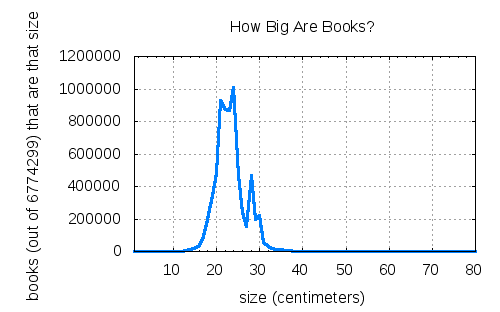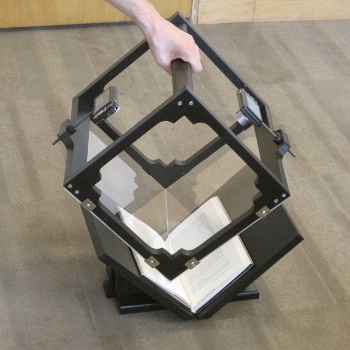UPDATE – 10 Oct 2014
Please see the BookLiberator Beta announcement — we now have beta kits for sale in our online store!
We had great attendance at our vendor table at the HOPE conference this weekend, where the BookLiberator prototypes attracted a tremendous amount of interest (even getting an excellent writeup on Forbes.com).
The BookLiberator is an affordable personal book digitizer. Working with Ian Sullivan and James Vasile, who came up with the design, we’ve just finalized the hardware setup and are now proceeding to manufacturing. We want to have them for sale at our online store as soon as possible; we’re aiming for a price of appx $120 for the kit plus around $200 for the pair of cameras (many customers will already have consumer-grade digital cameras, so we’ll offer the BookLiberator with and without).
What does the BookLiberator have to do with reframing copyright?
Everything — but not because people might use it for illegal copying. We don’t encourage that and it is not our goal. The reason the BookLiberator fits into our mission is precisely that it exposes more people to the direct experience of copyright restrictions. When people feel, in their daily lives, how much they are restricted by copyright, then we’ll start to have a mandate for change. All the pro-monopoly lobbyists in the world can’t prevail if people know the issues from their own personal experience. The BookLiberator is a way of giving people that experience.
So no, please don’t illegally share the contents of books. But remember every time you stop yourself from sharing why you’re stopping yourself: not because of any technological constraint, and not because sharing harms authors (it helps them far more), but because we’re imprisoning ourselves in the vestiges of an eighteenth-century printing industry regulation wholly unsuited to the Internet age.
We do encourage the many legal uses of the BookLiberator — as James Vasile noted in the Forbes.com article, it’s useful for archiving, annotation, and remixing, and is “no less legal than a photocopier or VCR”. Since monopoly-based publishing has proven ill-equipped to make these sorts of functionality accessible to its customers, we need to enable people to do these things for themselves, and that too is part of QuestionCopyright.org’s mission: a culture of text that is fully participatory and amenable to modern digital processing techniques.
Watch this space for more — we’ll post with updates as the BookLiberator approaches release.

Distribution of book sizes (sweet spot is around 30cm tall).


Do you have samples of the output? Are they OCR quality? As somebody who’s scanned books for Project Gutenberg in the past, I’m excited, but I want to see exactly what it gives you.
Yes, the output is OCR quality, since we have done OCR on it :-).
Check over at bookliberator.com, I believe there are some samples there (or reachable from there). Sorry I don’t know the exact link right now — but if/when you have it, can you post back here? That’ll help everyone.
Hi, is that possible? I mean, by shooting odd pages first and even ones second, having the software reassemblying the PDF at the end. Sort of ultra-low budget mode…Otherwise I guess it will be possible with ImageMagick and some scripting, just curious about this detail.
Thanks for this genious idea! 🙂
Hi, I was thinking: wouldn’t it be a lot easyer if you left the window facing you out of the BookLiberater?
It would make the lifting of the device redundant and I think it would take 30-50% less time to Liberate a Book? Just my 2 cents though, maybe you have stumbled across a problem working this way.
If I understand it correctly, your suggestion is leave the glass panes out, allowing the user to flip pages with the device in place. The problem with the idea would be holding pages flat. You’d be photographing curved surfaces which would obscure the text and drawings. At the beginning and end of books it would be hard to keep the device at the correct page. While the latter problem could be solved with a kind of point page-holder, to have good flat text you really want the sheet held against a glass pane. I imagine this becomes very important when you want the software to be machine read into something besides photographs.
It could be an idea to have one on a kind of hinge so you could swing it to the other side, or maybe use a mirror. But the whole point of it is to be quick, that way you have to take 2 different photos, you also have to be careful about the order (although it seems like it would be trivial to take to photos accidentally and screw up the order using the current liberator).
Personally it seems like it would be better to just get a flat bit of glass/transparent plastic to keep the pages down and mount the camera above it, take one picture for both pages.
I think one issue is that the books need to be ‘preserved’ and it’s easier to scan them in the / shape rather than flat. Maybe a custom lens or mirror setup could deangle out the pages from the wedge shape.
I agree that the idea for the V-shaped setup is probably to minimize wear on the book’s spine (especially important for paperbacks) and to limit the potential for crinkled or otherwise deformed pages when using the system at speed.
I can, however, see the potential for it to work with one camera without special lenses or mirrors using appropriately positioned lighting and some 3D transformation algorithms to “flatten” the pages.
There’s precedent for that.
Interesting.
I have been scanning Boy Scout literature for my own research, and to share the materials with others. I have usually been limiting my scanning to documents (magazine and pamphlets) that I could easily (and without damaging them) lay out on a photocopier/scanner.
But I had avoided the larger manuals because I didn’t want to damage the spine of them.
If low enough cost, this might be a solution for me.
That was great idea. I can, however, see the potential for it to work with one camera without special lenses or mirrors using appropriately positioned lighting and some 3D transformation algorithms to “flatten” the pages. Thank you.
I spoke to an Ion’s sales rep today, and they informed me they will no longer be producing the Book Saver because it wasn’t up to management expectations. It would be great it we could get this project up and running again. I would by a kit for sure!